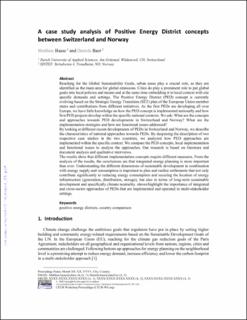| dc.contributor.author | Haase, Matthias | |
| dc.contributor.author | Baer, Daniela | |
| dc.date.accessioned | 2022-05-11T18:13:43Z | |
| dc.date.available | 2022-05-11T18:13:43Z | |
| dc.date.created | 2022-05-09T10:19:53Z | |
| dc.date.issued | 2021 | |
| dc.identifier.issn | 1613-0073 | |
| dc.identifier.uri | https://hdl.handle.net/11250/2995322 | |
| dc.description.abstract | Reaching for the Global Sustainability Goals, urban areas play a crucial role, as they are identified as the main area for global emissions. Cities do play a prominent role to put global goals into local policies and means and at the same time embedding it in local context with site specific demands and settings. The Positive Energy District (PED) concept is currently evolving based on the Strategic Energy Transition (SET) plan of the European Union member states and contributions from different initiatives. As the first PEDs are developing all over Europe, we have little knowledge on how the PED concept is implemented nationally and how first PED projects develop within the specific national contexts. We ask: What are the concepts and approaches towards PED developments in Switzerland and Norway? What are the implementation strategies and how are functional issues addressed?
By looking at different recent developments of PEDs in Switzerland and Norway, we describe the characteristics of national approaches towards PEDs. By deepening the description of two respective case studies in the two countries, we analyzed how PED approaches are implemented within the specific context. We compare the PED concepts, local implementation and functional issues to analyze the approaches. Our research is based on literature and document analysis and qualitative interviews.
The results show that different implementation concepts require different measures. From the analysis of the results, the conclusions are that integrated energy planning is more important than ever. Understanding the different dimensions of sustainable development in combination with energy supply and consumption is important to plan and realize settlements that not only contribute significantly to reducing energy consumption and securing the location of energy infrastructure (generation, distribution, storage), but also in terms of long-term sustainable development and specifically climate neutrality. shows/highlight the importance of integrated and cross-sector approaches of PEDs that are implemented and operated in multi-stakeholder settings. | en_US |
| dc.language.iso | eng | en_US |
| dc.publisher | CEUR | en_US |
| dc.relation.ispartof | CEUR Workshop Proceedings | |
| dc.rights | CC BY 4.0 | * |
| dc.rights.uri | https://creativecommons.org/licenses/by/4.0/ | * |
| dc.subject | Positive energy districts | en_US |
| dc.subject | Country comparison | en_US |
| dc.title | A case study analysis of Positive Energy District concepts between Switzerland and Norway | en_US |
| dc.title.alternative | A case study analysis of Positive Energy District concepts between Switzerland and Norway | en_US |
| dc.type | Peer reviewed | en_US |
| dc.type | Conference object | en_US |
| dc.type | Journal article | en_US |
| dc.description.version | publishedVersion | en_US |
| dc.rights.holder | © 2020 The authors | en_US |
| dc.subject.nsi | VDP::Teknologi: 500 | en_US |
| dc.source.journal | CEUR Workshop Proceedings | en_US |
| dc.identifier.cristin | 2022574 | |
| dc.relation.project | Norges forskningsråd: 257660 | en_US |
| cristin.ispublished | true | |
| cristin.fulltext | original | |
| cristin.qualitycode | 1 | |

